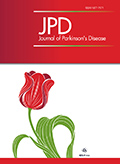Authors: Cubo, Esther | Martínez-Martín, Pablo | González-Bernal, Jerónimo | Casas, Elena | Arnaiz, Sandra | Miranda, Javier | Gámez, Pedro | Santos-García, Diego | Coppadis Study Group:
Collaborators: Adarmes, AD | Almeria, M | Alonso Losada, MG | Alonso Cánovas, A | Alonso Frech, F | Álvarez, I | Álvarez Sauco, M | Aneiros Díaz, A | Arnáiz, S | Arribas, S | Ascunce Vidondo, A | Aguilar, M | Ávila, MA | Bernardo Lambrich, N | Bejr-Kasem, H | Blázquez Estrada, M | Botí, M | Borrue, C | Buongiorno, MT | Cabello González, C | Cabo López, I | Caballol, N | Cámara Lorenzo, A | Carrillo, F | Carrillo Padilla, FJ | Casas, E | Catalán, MJ | Clavero, P | Cortina Fernández, A | Cosgaya, M | Cots Foraster, A | Crespo Cuevas, A | Cubo, E | de Deus Fonticoba, T | de Fábregues-Boixar, O | Díez-Fairen, M | Erro, E | Escalante, S | Estelrich Peyret, E | Fernández Guillán, N | Gámez, P | Gallego, M | García Caldentey, J | García Campos, C | García Moreno, JM | Gastón, I | Gómez Garre, MP | Gómez Mayordomo, V | González Aloy, J | González-Aramburu, I | González Ardura, J | González García, B | González Palmás, MJ | González Toledo, GR | Golpe Díaz, A | Grau Solá, M | Guardia, G | Hernández Vara, J | Horta-Barba, A | Idoate Calderón, D | Infante, J | Jesús, S | Kulisevsky, J | Kurtis, M | Labandeira, C | Labrador, MA | Lacruz, F | Lage Castro, M | Lastres Gómez, S | Legarda, I | López Ariztegui, N | López Díaz, LM | López Manzanares, L | López Seoane, B | Lucas del Pozo, S | Macías, Y | Mata, M | Martí Andres, G | Martí, MJ | Martínez Castrillo, JC | Martinez-Martin, P | McAfee, D | Meitín, MT | Menéndez González, M | Méndez del Barrio, C | Mir, P | Miranda Santiago, J | Morales Casado, MI | Moreno Diéguez, A | Nogueira, V | Novo Amado, A | Novo Ponte, S | Ordás, C | Pagonabarraga, J | Pareés, I | Pascual-Sedano, B | Pastor, P | Pérez Fuertes, A | Pérez Noguera, R | Planas-Ballvé, A | Planellas, L | Prats, MA | Prieto Jurczynska, C | Puente, V | Pueyo Morlans, M | Redondo Rafales, N | Rodríguez Méndez, L | Rodríguez Pérez, AB | Roldán, F | Ruíz De Arcos, M | Ruíz Martínez, J | Sánchez Alonso, P | Sánchez-Carpintero, M | Sánchez Díez, G | Sánchez Rodríguez, A | Santacruz, P | Santos García, D | Segundo Rodríguez, JC | Seijo, M | Sierra Peña, M | Solano Vila, B | Suárez Castro, E | Tartari, JP | Valero, C | Vargas, L | Vela, L | Villanueva, C | Vives, B | Villar, MD
Article Type:
Research Article
Abstract:
Background: The asymmetry of motor manifestations present in Parkinson’s disease (PD) suggests the existence of differences between both hemispheres. As a consequence, this asymmetry might contribute to different PD clinical phenotypes. Objective: To study the relationship between motor symptom laterality with motor, non-motor symptoms (NMS), freezing of gait (FOG), and quality of life (QoL) impairment in PD. Methods: In this cross-sectional study, we measured motor symptoms severity and complications with the Unified Parkinsons’ disease Rating Scale (UPDRS), FOG with the FOG questionnaire, QoL with the 39-item PD Quality of Life Questionnaire Summary Index, and NMS with
…the NMS, Visual Analogue Scales for Pain and Fatigue, Beck Depression Inventory-II, Impulsive-Compulsive Disorders, and PD Sleep and Cognitive Rating scales. We defined left and right motor laterality using the UPDRS part III. We used comparative, regression, and effect size analyses to evaluate the impact of asymmetry on motor and NMS, FOG, and QoL. Results: 342 left (LPD) and 310 right (RPD) patients, with a mean age of 62.0±8.8 years, were included. In multivariate regression analysis, LPD was associated with a greater motor (OR = 1,50, 95% CI 1.02–2.21), FOG (OR = 1.56, 95% CI 1.01–2.41), and overall NMS impairment (OR = 1.43, 95% CI 1.001–2.06), and better QoL (OR = 0.52 95% CI 0.32–0.85). Overall, only a mild effect size was found for all comparisons in which significant differences were present. Conclusion: In this large multicenter study, motor symptom laterality seems to carry a mild but significant impact on PD clinical manifestations, and QoL.
Show more
Keywords: Parkinson’s disease, asymmetry, motor, non-motor symptoms, quality of
life
DOI: 10.3233/JPD-202067
Citation: Journal of Parkinson's Disease,
vol. 10, no. 4, pp. 1611-1620, 2020






